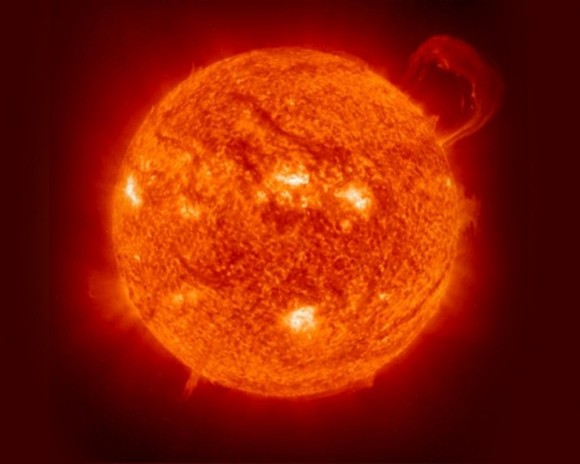
(http://www.universetoday.com/84361/plasma/)
You may recall from earlier readings that
plasma occurs at extremely high temperatures. You also
may recall from a grade school science class that the
sun is very hot, ranging from 15 million degrees
Celsius in it's core, to a mere 6,000 degrees Celsius
in the photosphere (the part we actually see). It
stands to reason, then, that the sun is not a large
sphere of hot gas, but a large sphere of plasma. The
whole idea behind a plasma is that a steady supply of
enough energy will free electrons from their orbits
and the end result will be a mess of free electrons
and positive ions. The sun has more than enough energy
to do that.
Not only that, but during our discussion of the aurora, it was mentioned that there was plasma coming from the sun (the solar wind). This means that the sun not only has enough energy to keep the electrons from their orbits around a nucleus, but also has enough energy to keep electrons free millions of miles away from the sun itself. This gives credence to our earlier claim that 99% of our universe is made up of plasma. If our sun is an average sized star (it is), and it has enough energy to eject plasma to the edge of our solar system and beyond, then all the other stars in the universe do as well. Stars already comprised the bulk of matter in the universe, and we can now say that stars are made out of plasma.
Not only that, but during our discussion of the aurora, it was mentioned that there was plasma coming from the sun (the solar wind). This means that the sun not only has enough energy to keep the electrons from their orbits around a nucleus, but also has enough energy to keep electrons free millions of miles away from the sun itself. This gives credence to our earlier claim that 99% of our universe is made up of plasma. If our sun is an average sized star (it is), and it has enough energy to eject plasma to the edge of our solar system and beyond, then all the other stars in the universe do as well. Stars already comprised the bulk of matter in the universe, and we can now say that stars are made out of plasma.